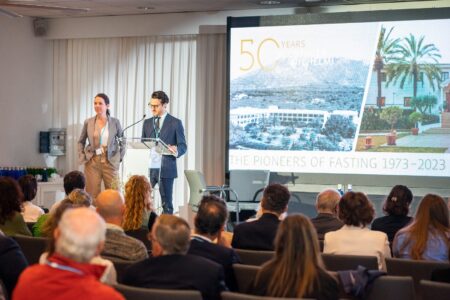The science of longevity is advancing rapidly. What a few decades ago was seen as science fiction - cellular reprogramming, senolytic therapies or artificial intelligence applied to drug discovery - now occupies a central place in leading laboratories and attracts billions in private investment. However, the big obstacle is no longer scientific, but cultural and regulatory: trust.
As the US experience shows, biomedical advances do not automatically translate into social acceptance and clinical use. Recent surveys show that a majority of citizens remain sceptical: they prefer a shorter but healthy life rather than a longer one conditioned by disease.
Europe and Spain are no strangers to this dynamic. The lack of confidence is multiplied here by an added factor: regulatory lag. Science and marketing advance faster than legislation and bureaucracy, which creates an ambiguous terrain where innovation is perceived as suspicious because it is not yet legally recognised. In this context, public caution towards emerging therapies becomes a vicious circle: without clear regulation there is no trust, and without trust there is no pressure to speed up regulation.
The regulatory framework in Spain and Europe
In Spain, medicinal products and therapies must pass through the Spanish Agency for Medicines and Health Products (AEMPS) and, in the European framework, by the European Medicines Agency (EMA). The system is robust and guarantees safety, but it is slow and very rigid: it requires years of clinical trials and strict protocols before an innovation is authorised.
This is why vaccines, antibiotics and conventional drugs are almost automatically trusted: they were approved decades ago, they are integrated in the Law on the Guarantees and Rational Use of Medicines and in the National Health Systemand their use is perceived as normalised. No one questions, for example, the need for regular flu vaccinations or broad-spectrum antibiotics, even though they have known risks such as bacterial resistance or adverse effects.
On the other hand, therapies of regenerative medicine o integrative encounter a normative wall. The Regulation (EC) 1394/2007 on Medicinal Products for Advanced Therapies (ATMPs) regulates stem cell, gene therapy and tissue engineering treatments, but their practical application is so restrictive that only large companies with million-dollar investments can go through the process. In Spain, private clinics offering autologous stem cell treatments for cartilage regeneration or neurological recovery have been sanctioned or closed by the AEMPS, although patients reported improvements.
Another clear example was the controversy in 2018 over the homeopathy. Although thousands of people were using it, the Ministry of Health decided to withdraw it from pharmacies for lack of sufficient scientific evidence, sending a clear public message: unregulated is unreliable. At the same time, emerging therapies such as photobiomodulation or the non-invasive neuromodulation are being researched in universities and hospitals, but their clinical application is limited because they do not yet fit into the category of "medicinal product" or "medical device" under current regulations.

Excessive caution or justified caution?
In Spain and in the European Union, the precautionary principle dominates health policy. This approach protects against potential risks, but often slows down the uptake of innovations. The citizen then perceives that what is not authorised is "dangerous", when in many cases it is "pending regulation".
The result is a constant tension: on the one hand, the promise of extending life in good health; on the other, the fear of over-promising without regulatory backing. Compared to the US, where private capital is more aggressively driving experimentation, Europe is moving more slowly, often at the cost of losing attractiveness for investment and development of biomedical start-ups.

A cultural shift: from the white coat to the like in the networks
The challenge is not only legal, but also cultural. Traditionally, medical authority has been represented with normative symbolsThe impeccable white coat, the specialist's tie or the inaccessible technical language. This framework conveyed security because it fitted in with the hierarchical and normative vision of medicine.
But new generations of doctors and therapists are breaking with that image. Many young professionals no longer wear a dressing gown or tieThey seek to be perceived as approachable, modern and accessible. They prefer to convey trust through accompaniment, active listening and innovation, not through external symbols of authority. This transition reflects a change of mentality: from a top-down, top-down medicine, towards a medicine that is more "credible", more "modern" and more "modern". disruptive, horizontal and participatorywhere the patient becomes the protagonist of his or her own care.
The field of longevity is at a turning point. In the US, initiatives are emerging such as the Public Longevity Group (PLG)which seeks to measure and anticipate social perception in order to design trust strategies. Europe, by contrast, lacks similar platforms with public impact. If progress is not made in this area, the continent runs the risk of seeing the longevity revolution flourish in other more agile markets while it is perceived here as a distant and elitist debate.
The lack of confidence in longevity, both in Spain and in the rest of Europe, is not only due to public scepticism, but to the gap between the speed of science and the slowness of regulation. Examples such as the strict regulation of stem cell therapies, the withdrawal of homeopathy from pharmacies or the limitations for emerging therapies illustrate an underlying problem: while the "classical" is accepted without question, the new generates mistrust because it does not yet fit into the legal framework.
It remains to be decided whether this prudence is an excess - relegating us to a secondary role in the biomedical revolution - or a reasonable protection that avoids premature risks. What is certain is that, without trust built on transparency, clear regulation and a cultural communication effort, longevity will continue to be perceived as a promise rather than a reality.






